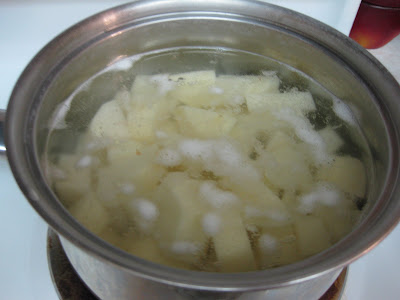All of the settled immigrants including Germans, French, English, Creoles, Africans, and Mexicans all played a part in developing this full-bodied Cajun cuisine.
Creole people had a more aristocratic heritage from England and all but shut out those that did not share their birthright. The settlers found a new home in the prairies and bayous and became well versed in the art of survival.
Cajun food history came together as a varied way of living off the land. The more refined Creole peoples remained in the city and enjoyed a more rich and elegant menu of many choices. Cajun people were poor and made homes in rural areas and deep in the marsh and swamps of Louisiana.
Initially, Cajun food never inspired a second thought and was rather ordinary. Poor immigrants simply had to "make do" with the cheapest foods and had no access to complimentary spices.
As more settlers came to southern Louisiana, the immigrants melded together with each ethnicity lending their unique spirit and spices to their somewhat bland food and turned around their poorly defined menu into what became Cajun Food with a "kick."
A mixture of all ingredients in one pot became the staple of great Cajun food history. This flavorful type of cooking branched out into the southern states with each creating a new take on old recipes.
Settlers continued to move along throughout the south taking a piece of Cajun food history with them. Red beans and rice in Louisiana became peas and rice, or "hoppin john" in South Carolina while in Florida a different rendition of this dish became known as black beans and rice.
Many years later, derived from Cajun food history brought about new menus of "Southern Hospitality." The same main ingredients prepared in various ways.
Traditional Cajun food and recipes have been passed down and we continue to take pleasure in these "one pot" dishes melded with the goodness of Cajun food history.











 In separate pots, cook potatoes and carrots until almost done. (Cook the onions with the potatoes.)
In separate pots, cook potatoes and carrots until almost done. (Cook the onions with the potatoes.)
 Reserve water from potatoes and carrots.
Reserve water from potatoes and carrots.  Serve with breadsticks or saltines.
Serve with breadsticks or saltines.







 The result will be a semi-stiff, but still soft dough. Should not stick to your hands. If it does, add a tiny bit of powdered sugar. (Again, sorry for the bad picture.)
The result will be a semi-stiff, but still soft dough. Should not stick to your hands. If it does, add a tiny bit of powdered sugar. (Again, sorry for the bad picture.) Roll into balls. Not too big. About 3/4 of an inch or a little less. (Yeah, battery finally charged! Boy there is sure a difference.)
Roll into balls. Not too big. About 3/4 of an inch or a little less. (Yeah, battery finally charged! Boy there is sure a difference.) Put between pretzels to make a sandwich.
Put between pretzels to make a sandwich. Put in freezer for about an hour or until firm.
Put in freezer for about an hour or until firm.
 Keep in fridge until ready to serve.
Keep in fridge until ready to serve.
 If you are not grilling these outside, HI broil works great, too. Line a cookie sheet with foil. Place cooling racks over the foil. Place chicken across the racks. DISCARD the marinade!
If you are not grilling these outside, HI broil works great, too. Line a cookie sheet with foil. Place cooling racks over the foil. Place chicken across the racks. DISCARD the marinade! Broil chicken for about 5 or 6 minutes on each side, turn over and repeat. The tenders cook fast so this can be done in about 10 minutes.
Broil chicken for about 5 or 6 minutes on each side, turn over and repeat. The tenders cook fast so this can be done in about 10 minutes. Super simple. Super fast. My kind of dinner!
Super simple. Super fast. My kind of dinner!






 I prefer to cook it on medium to help start the flavors to mix together. I use a whisk to make sure the soup mixes into the broth well. Once it is slightly boiling, grate carrots into the pot. These add great flavor and texture. And my kids eat the soup better if they are grated and not chopped. Plus, they cook faster that way. Allow the soup to continue a medium boil.
I prefer to cook it on medium to help start the flavors to mix together. I use a whisk to make sure the soup mixes into the broth well. Once it is slightly boiling, grate carrots into the pot. These add great flavor and texture. And my kids eat the soup better if they are grated and not chopped. Plus, they cook faster that way. Allow the soup to continue a medium boil. Finally, add chicken. Add a dash of pepper for taste. I usually taste test along the way just to be sure it doesn't need a little more chicken soup base or bouillon. The cream of chicken soup usually does a great job of adding great flavor while still keeping the broth very chicken-noodle-like. I let it cook just a couple minutes past the noodles being done to be sure the chicken has absorbed lots of flavor from the broth.
Finally, add chicken. Add a dash of pepper for taste. I usually taste test along the way just to be sure it doesn't need a little more chicken soup base or bouillon. The cream of chicken soup usually does a great job of adding great flavor while still keeping the broth very chicken-noodle-like. I let it cook just a couple minutes past the noodles being done to be sure the chicken has absorbed lots of flavor from the broth.




 Let set up for about 5 minutes and then serve.
Let set up for about 5 minutes and then serve.












